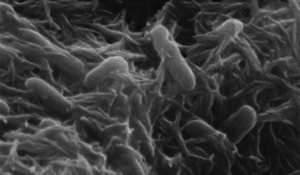Shewanella facts for kids
Quick facts for kids Shewanella |
|
|---|---|
 |
|
| Shewanella oneidensis | |
| Scientific classification | |
| Kingdom: | |
| Phylum: | |
| Class: |
Gamma Proteobacteria
|
| Order: |
Alteromonadales
|
| Family: |
Shewanellaceae
Ivanova et al. 2004
|
| Genus: |
Shewanella
MacDonell and Colwell 1985
|
| Type species | |
| Shewanella putrefaciens |
|
| Species | |
|
S. abyssi |
|
Shewanella is a special type of bacteria that lives mostly in the ocean. It's the only group of bacteria in its family, called Shewanellaceae. These tiny living things are amazing because they can change metals, making them less harmful and helping them break down in the environment.
Contents
What are Bacteria?
Bacteria are tiny, single-celled living things. They are so small you need a microscope to see them! Bacteria are found almost everywhere on Earth. They live in soil, water, air, and even inside our bodies.
Most bacteria are harmless, and many are very helpful. For example, some bacteria help us digest food. Others help clean up pollution in the environment. Shewanella bacteria are one of these helpful types.
Where Shewanella Lives
Shewanella bacteria are mostly found in marine environments. This means they live in the ocean, from shallow waters to the deep sea. Some types of Shewanella can even survive in very cold places, like the Arctic and Antarctica.
They can also be found in places where there isn't much oxygen. This is important because it helps them do their special job of changing metals.
Shewanella's Special Abilities
Shewanella bacteria have a unique ability to interact with metals. They can change the chemical form of metals. This process is called "metal reduction."
- Changing Metals: Imagine a metal like iron or uranium. Shewanella can take these metals and change them into a different form. This new form is often less toxic or harmful.
- Breathing Metals: Just like we breathe oxygen, some Shewanella bacteria can "breathe" metals. They use metals instead of oxygen to get energy. This is a very unusual way for a living thing to get energy!
- Making Electricity: Because they can move electrons around when changing metals, some scientists are studying if Shewanella can help create bio-batteries or fuel cells. These could be a way to make clean energy.
How Shewanella Helps Us
The special abilities of Shewanella make them very useful for solving real-world problems.
Cleaning Up Pollution
One of the most important uses for Shewanella is in cleaning up pollution.
- Toxic Metals: Many industrial activities can release harmful metals into the environment. These metals can pollute water and soil. Shewanella can change these toxic metals into forms that are less dangerous. This helps clean up polluted sites.
- Radioactive Waste: Some types of Shewanella can even help with radioactive waste. They can change radioactive elements like uranium, making them less likely to spread in water. This is a big help in managing dangerous waste.
Future Uses
Scientists are still learning about all the ways Shewanella can be helpful.
- Energy Production: As mentioned, their ability to move electrons could lead to new ways of making electricity.
- Bioremediation: This is the use of living things to clean up pollution. Shewanella is a great example of a microbe that can be used for bioremediation.
Conclusion
Shewanella bacteria are tiny but mighty! Their unique ability to interact with metals makes them important for understanding how elements move in the environment. They also offer exciting possibilities for cleaning up pollution and even creating new forms of energy. These little ocean dwellers are truly fascinating.
See also
 In Spanish: Shewanella para niños
In Spanish: Shewanella para niños

